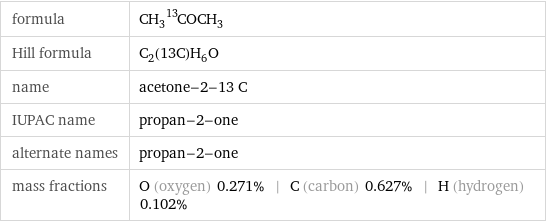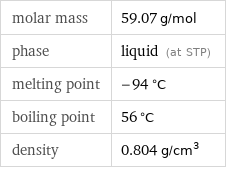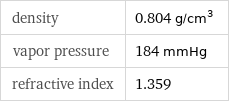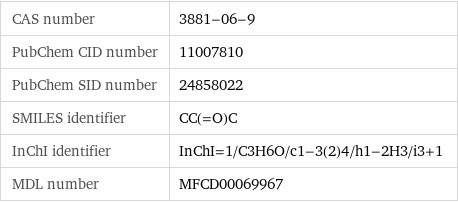Input interpretation

acetone-2-13 C
Chemical names and formulas

formula | CH_3^13COCH_3 Hill formula | C_2(13C)H_6O name | acetone-2-13 C IUPAC name | propan-2-one alternate names | propan-2-one mass fractions | O (oxygen) 0.271% | C (carbon) 0.627% | H (hydrogen) 0.102%
Lewis structure

Draw the Lewis structure of acetone-2-13 C. Start by drawing the overall structure of the molecule, ignoring potential double and triple bonds: Count the total valence electrons of the carbon (n_C, val = 4), hydrogen (n_H, val = 1), and oxygen (n_O, val = 6) atoms: 3 n_C, val + 6 n_H, val + n_O, val = 24 Calculate the number of electrons needed to completely fill the valence shells for carbon (n_C, full = 8), hydrogen (n_H, full = 2), and oxygen (n_O, full = 8): 3 n_C, full + 6 n_H, full + n_O, full = 44 Subtracting these two numbers shows that 44 - 24 = 20 bonding electrons are needed. Each bond has two electrons, so in addition to the 9 bonds already present in the diagram add 1 bond. To minimize formal charge oxygen wants 2 bonds and carbon wants 4 bonds. Identify the atoms that want additional bonds and the number of electrons remaining on each atom: Fill in the 1 bond by pairing electrons between adjacent highlighted atoms: Answer: | |
Basic properties

molar mass | 59.07 g/mol phase | liquid (at STP) melting point | -94 °C boiling point | 56 °C density | 0.804 g/cm^3
Units

Liquid properties (at STP)

density | 0.804 g/cm^3 vapor pressure | 184 mmHg refractive index | 1.359
Units

Non-standard atom properties

C-13 | 1
Chemical identifiers

CAS number | 3881-06-9 PubChem CID number | 11007810 PubChem SID number | 24858022 SMILES identifier | CC(=O)C InChI identifier | InChI=1/C3H6O/c1-3(2)4/h1-2H3/i3+1 MDL number | MFCD00069967
Safety properties

flash point | -17.22 °C